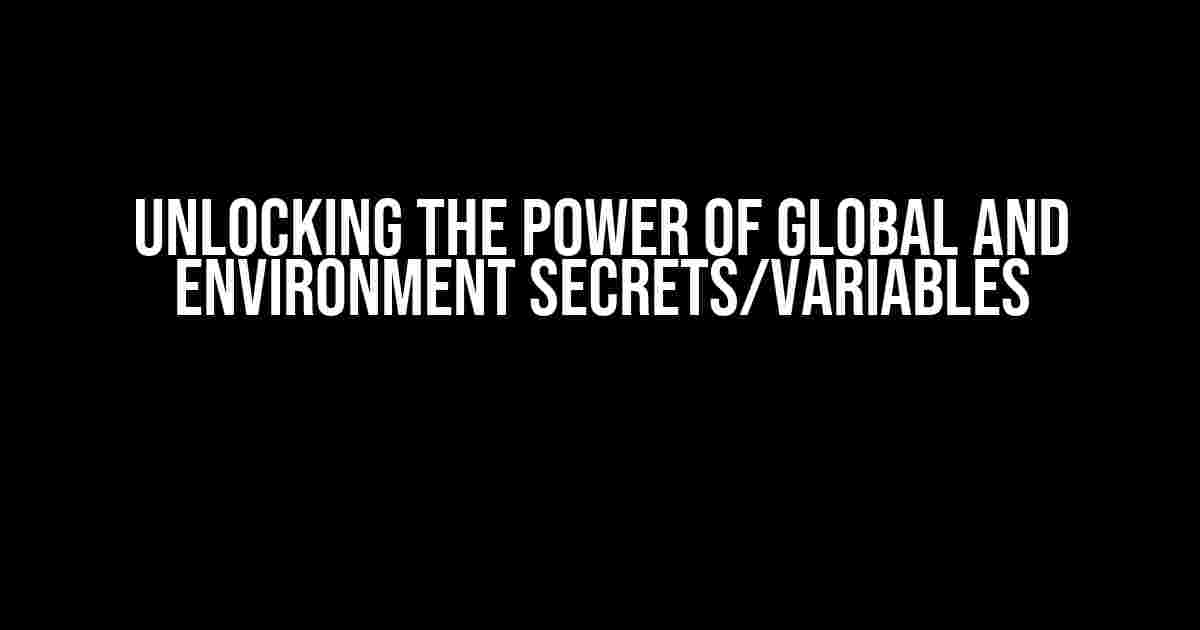Are you tired of repeating the same code snippets over and over again in your projects? Do you wish there was a way to centralize and manage your application’s configuration in a more efficient manner? Look no further! In this article, we’ll delve into the world of global and environment secrets/variables, and explore how they can revolutionize the way you develop and deploy your applications.
What are Global and Environment Secrets/Variables?
In computing, a secret or variable is a named storage location that holds a value. Global and environment secrets/variables are a type of variable that is accessible across different parts of an application or even across multiple applications. They are typically used to store sensitive information, such as API keys, database credentials, or encryption keys, that should not be hardcoded into your code.
Types of Global and Environment Secrets/Variables
There are two primary types of global and environment secrets/variables:
- Environment Variables: These are variables that are set outside of your application code, typically through environment settings or configuration files. They are specific to the environment in which your application is running, and can be used to override default values or settings.
- Global Variables: These are variables that are defined within your application code, but are accessible across different parts of the application. They are typically used to store values that are used across multiple components or modules.
Why Use Global and Environment Secrets/Variables?
Using global and environment secrets/variables offers several benefits, including:
- Security: By storing sensitive information in secrets/variables, you can avoid hardcoding them into your code, reducing the risk of exposure and unauthorized access.
- Flexibility: Environment secrets/variables allow you to easily switch between different environments, such as development, testing, and production, without having to modify your code.
- Reusability: Global secrets/variables enable you to reuse code across different parts of your application, reducing duplication and increasing efficiency.
- Easy Maintenance: Centralizing your application’s configuration in secrets/variables makes it easier to update and maintain, reducing the risk of errors and downtime.
How to Use Global and Environment Secrets/Variables
Using global and environment secrets/variables involves several steps:
Step 1: Define Your Secrets/Variables
The first step is to define your secrets/variables. This can be done using a variety of methods, including:
- Environment files (e.g., `.env` files)
- Configuration files (e.g., `config.json` files)
- Secrets management tools (e.g., HashiCorp’s Vault)
- Cloud-based services (e.g., AWS Secrets Manager)
Step 2: Set Your Secrets/Variables
Once you’ve defined your secrets/variables, you’ll need to set them. This can be done using a variety of methods, including:
export API_KEY="my_secret_api_key"
or
api_key = os.environ.get('API_KEY')
Step 3: Use Your Secrets/Variables
Now that you’ve set your secrets/variables, you can use them in your code. For example:
import os
api_key = os.environ.get('API_KEY')
# Use the API key to make a request
response = requests.get(f"https://api.example.com/{api_key}")
Best Practices for Global and Environment Secrets/Variables
When using global and environment secrets/variables, it’s essential to follow best practices to ensure security and efficiency:
- Use Secure Storage: Store your secrets/variables in a secure location, such as an encrypted file or a secrets management tool.
- Keep Them Secret: Avoid exposing your secrets/variables in your code or in public repositories.
- Use Environment-Specific Variables: Use environment-specific variables to avoid conflicts and ensure flexibility.
- Rotate and Update: Regularly rotate and update your secrets/variables to maintain security and compliance.
- Monitor and Audit: Monitor and audit your secrets/variables to detect and respond to unauthorized access.
Tools and Services for Global and Environment Secrets/Variables
There are several tools and services available to help you manage and use global and environment secrets/variables, including:
| Tool/Service | Description |
|---|---|
| HashiCorp’s Vault | A secrets management tool that provides secure storage and rotation of secrets. |
| AWS Secrets Manager | A cloud-based service that provides secure storage and rotation of secrets. |
| Docker Secrets | A containerization platform that provides secure storage and rotation of secrets. |
| Kubernetes Secrets | A container orchestration platform that provides secure storage and rotation of secrets. |
Conclusion
In conclusion, global and environment secrets/variables are a powerful tool for managing and securing sensitive information in your applications. By following best practices and using the right tools and services, you can unlock the full potential of secrets/variables and take your application development to the next level. Remember to keep your secrets secret, and always prioritize security and flexibility in your development workflow.
Now that you’ve mastered the art of global and environment secrets/variables, it’s time to put your knowledge into practice. Go ahead, create your own secrets/variables, and watch your applications come to life!
Frequently Asked Question
Get ready to uncover the secrets of the global environment and unravel the mysteries of our planet!
What is the most critical environmental issue facing our planet today?
Climate change is undoubtedly the most pressing environmental concern of our time. Rising global temperatures, melting ice caps, and extreme weather events are all interconnected symptoms of a bigger problem – the increasing levels of greenhouse gases in our atmosphere, primarily CO2. The clock is ticking, and it’s essential we take collective action to reduce our carbon footprint and transition to renewable energy sources.
What is the current state of the world’s biodiversity, and what can we do to protect it?
The world’s biodiversity is facing an unprecedented crisis, with species extinction rates 100 to 1,000 times higher than the natural rate. Habitat destruction, pollution, overfishing, and climate change are the primary drivers of this decline. To combat this, we must adopt a holistic approach, including the preservation of natural habitats, sustainable land-use practices, reduced pollution, and the promotion of eco-friendly lifestyles. Every small action counts, from reducing plastic use to supporting conservation efforts!
How does human activity impact the global water cycle, and what can we do to conserve this vital resource?
Human activities, such as deforestation, urbanization, and agriculture, alter the global water cycle, leading to changes in precipitation patterns, reduced water quality, and increased water scarcity. To conserve water, we must adopt water-saving technologies, implement efficient irrigation systems, and protect natural habitats like forests and wetlands. Additionally, reducing our energy consumption and transitioning to renewable energy sources can help mitigate the water footprint of our daily lives.
What role does the ocean play in regulating the Earth’s climate, and how can we protect it?
The ocean is a vital component of the Earth’s climate system, absorbing about 25% of the sun’s energy and producing half of the oxygen we breathe. However, it’s facing unprecedented threats from pollution, overfishing, and climate change. To protect the ocean, we must reduce plastic waste, establish marine protected areas, and promote sustainable fishing practices. By taking care of the ocean, we’re essentially taking care of ourselves and the planet!
What can individuals do to make a positive impact on the environment, and how can we inspire collective action?
Every individual has the power to make a difference! Start by making conscious choices in your daily life, such as reducing energy consumption, using public transport, and buying sustainable products. Educate yourself and others about environmental issues, and support organizations working towards a greener future. Together, we can create a ripple effect of positive change and inspire collective action to protect our planet!



